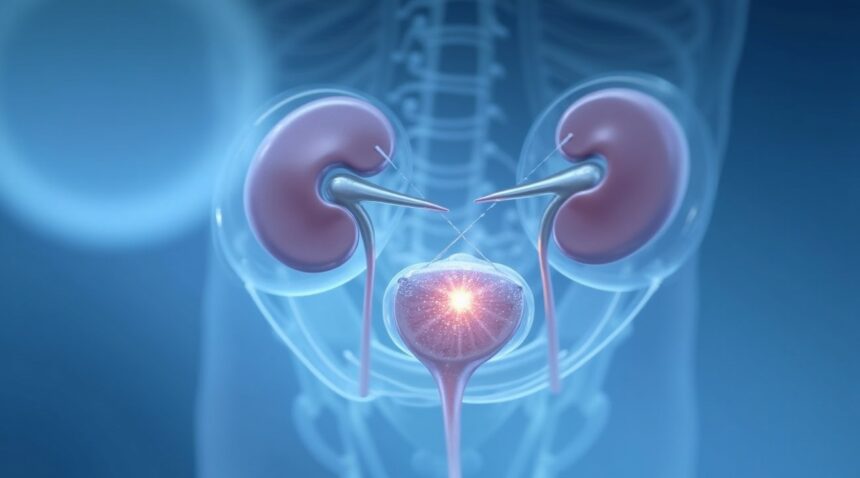Revolutionary Magnetic Micro-Robot Developed to Dissolve Kidney Stones
Researchers at the University of Waterloo have unveiled a groundbreaking 1 x 1 x 12 mm magnetic micro-robot capable of dissolving kidney stones in just a few days, revolutionizing the standard treatment protocol.
This cutting-edge micro-robot uses external magnetic control and relies on real-time ultrasound imaging to navigate through the urinary tract. By delivering the enzyme urease directly to the kidney stones, the device allows for rapid and precise breakdown of the stones without damaging nearby tissues or requiring surgery.
Key Takeaways
- The magnetic micro-robot measures only 1 x 1 x 12 mm and moves through the urinary tract using real-time ultrasound and external magnetic control.
- Treatment is accelerated from the typical weeks or months associated with oral medications to only a few days.
- Localized enzyme delivery of urease ensures that only the kidney stones are affected, leaving healthy tissues unharmed.
- Minimally invasive design eliminates the need for surgical procedures and reduces recovery time and discomfort for patients.
- Preclinical tests in 3D-printed urinary tract models have been successful, showing precise navigation and effective stone dissolution. Upcoming studies on animals are planned, with human clinical trials to follow.
This innovation represents a major leap forward in urological treatment, combining precision robotics, real-time imaging, and biochemical targeting to dramatically improve patient outcomes. More on the research can be found via the University of Waterloo press release.
Revolutionary Micro-Robot Dissolves Kidney Stones in Days Instead of Months
Researchers at the University of Waterloo have developed a groundbreaking soft micro-robot that promises to transform kidney stone treatment. This innovative device measures just 1 x 1 x 12 mm, making it small enough to navigate through the urinary tract while delivering powerful stone-dissolving capabilities directly to the target site.
The magnetic microrobot consists of a flexible strip crafted from a hydrogel/elastomer mixture, strategically embedded with the enzyme urease. A tiny magnet positioned at one end enables precise navigation through the body’s internal pathways. This design allows the device to bend and flex as it moves through the urinary system, adapting to the natural curves and passages without causing discomfort.
Precision Navigation and Targeted Treatment
Navigation through the urinary tract relies on a sophisticated external control system. Medical professionals guide the device using a motorized external magnet while monitoring its progress through real-time ultrasound imaging. This combination provides unprecedented accuracy in positioning the micro-robot exactly where it’s needed most.
Once the device reaches the kidney stone, it begins the dissolution process immediately. The embedded enzyme urease works to break down the stone into tiny particles that can pass naturally through the urinary system. This targeted drug delivery approach concentrates the treatment precisely at the stone’s location, maximizing effectiveness while minimizing exposure to healthy tissue.
The speed of treatment represents perhaps the most significant advancement. Traditional oral medications for kidney stone dissolution typically require weeks or months to show results, and success isn’t guaranteed. This new robotic navigation system accomplishes the same goal in just days, dramatically reducing patient discomfort and anxiety associated with prolonged treatment periods.
The minimally invasive nature of this approach eliminates the need for surgical procedures in many cases. Patients can avoid the risks, recovery time, and potential complications associated with more aggressive interventions. The ultrasound-guided control system ensures that medical teams can monitor the entire process in real-time, adjusting the robot’s position as needed for optimal results.
This kidney stone dissolution technology represents a major leap forward in urological treatment. The combination of precise robotic control, targeted enzyme delivery, and real-time imaging creates a treatment option that’s both more effective and more comfortable for patients. As this technology continues to develop, it may become the preferred first-line treatment for kidney stones, offering hope to millions of people who suffer from this painful condition.
How the Magnetic Navigation System Works
The magnetic navigation system represents a breakthrough in precision medicine for kidney stone treatment. This technology is fascinating because it eliminates the need for traditional surgical interventions while delivering targeted therapy directly to the stone location.
Healthcare providers begin the procedure by introducing the micro-robot through a catheter-based approach that requires no surgical incisions. This minimally invasive method allows the tiny device to enter through the bladder or ureter, making the entire process significantly more comfortable for patients compared to conventional stone removal techniques.
Precise Robot Control and Targeting
Once the micro-robot reaches the urinary system, an external magnetic device takes control of its movement. The magnetic navigation system works in conjunction with real-time ultrasound imaging, creating a sophisticated guidance mechanism that allows healthcare providers to direct the robot with remarkable accuracy. This combination ensures the device reaches the exact location of the kidney stone without causing damage to surrounding tissues.
The precision of this magnetic control system offers several advantages:
- Real-time positioning adjustments based on ultrasound feedback
- Ability to navigate complex urinary tract anatomy
- Controlled movement that prevents tissue damage
- Direct targeting of stone location without affecting healthy areas
The urease enzyme within the robot begins its work immediately upon reaching the kidney stone site. This enzyme converts urea naturally present in urine, creating a localized pH increase that specifically targets uric acid stones. The chemical reaction dissolves the stones directly at their location, eliminating the need for mechanical breaking or extraction procedures.
This targeted dissolution approach offers rapid relief compared to traditional methods. While conventional treatments might require multiple sessions or lengthy recovery periods, the magnetic robot system provides immediate stone breakdown at the molecular level. The localized nature of the treatment means surrounding healthy tissue remains unaffected throughout the process.
The non-surgical approach significantly reduces patient discomfort and recovery time. Unlike procedures that require incisions or mechanical stone breaking, this magnetic navigation system works entirely within the natural pathways of the urinary system. Patients can expect minimal downtime and a faster return to normal activities.
What makes this system particularly effective is its ability to provide real-time feedback during treatment. Healthcare providers can monitor the robot’s progress through continuous ultrasound imaging, adjusting the magnetic field as needed to ensure optimal positioning and enzyme delivery. This level of control wasn’t possible with previous kidney stone treatments.
The magnetic navigation technology also allows for multiple treatment sessions if needed, without additional invasive procedures. If a stone proves larger than initially assessed, healthcare providers can simply reintroduce the robot and continue treatment. This flexibility makes the system adaptable to various stone sizes and compositions.
The combination of magnetic control and enzyme delivery creates a synergistic effect that maximizes treatment efficiency. While the magnetic system ensures precise positioning, the urease enzyme provides the chemical action needed for stone dissolution. This dual approach addresses both the targeting and treatment aspects of kidney stone removal in a single, coordinated system.
For patients who have experienced the pain and complications of traditional kidney stone treatments, this magnetic navigation system offers a welcome alternative. The rapid relief provided by direct stone dissolution, combined with the non-surgical approach, represents a significant advancement in urological care. Healthcare providers can now offer patients a treatment option that’s both effective and comfortable, changing the entire experience of kidney stone management.

Major Advantages Over Current Treatment Options
Traditional kidney stone treatment approaches often leave patients stuck in a frustrating cycle of slow recovery and potential complications. Most patients endure oral drug regimens that stretch across weeks or months, while urgent cases require surgical intervention that carries inherent risks. I’ve seen how this lengthy process can drain both patients and healthcare systems.
Accelerated Treatment Timeline
The magnetic robot technology transforms the treatment landscape by breaking down kidney stones and enabling natural passage within just a few days. This dramatic reduction in treatment time means patients experience faster pain relief compared to conventional methods. Instead of waiting months for medication to slowly dissolve stones, the robotic system actively targets and fragments the problematic formations.
Enhanced Patient Safety and Outcomes
This innovative approach particularly benefits specific patient populations who struggle with traditional treatments. Individuals experiencing frequent kidney stone recurrences—a problem affecting a significant portion of patients—can avoid the repeated cycle of lengthy medication courses or multiple surgeries. The non-surgical nature of magnetic robot therapy also provides a crucial alternative for patients who can’t tolerate oral medications or face elevated surgical risks due to chronic infections or other medical conditions.
The reduced invasiveness of this technology offers several compelling advantages:
- Elimination of repeat surgeries for recurring stones
- Decreased reliance on long-term medication regimens
- Lower risk of complications associated with traditional surgical procedures
- Faster return to normal activities and quality of life
- Reduced strain on healthcare resources and operating room schedules
Healthcare systems stand to benefit significantly from this advancement. By reducing the need for complex surgical procedures and shortening treatment durations, hospitals can allocate resources more efficiently while improving patient outcomes. The technology’s ability to prevent recurrence patterns could substantially decrease the overall burden on urological departments.
For patients who previously faced limited options due to medical contraindications, the magnetic robot system opens new possibilities for effective treatment. This breakthrough represents a shift from reactive management to proactive stone elimination, potentially revolutionizing how medical professionals approach kidney stone care. The combination of speed, safety, and effectiveness positions this technology as a game-changing alternative that addresses the shortcomings of current treatment protocols.
Successful Testing Results and Clinical Progress
The preclinical testing phase showcased remarkable achievements using a life-size 3D-printed urinary tract model that replicated human anatomy with impressive accuracy. This sophisticated testing environment allowed researchers to validate the magnetic robot’s core capabilities under conditions that closely mirror real-world applications. The robot demonstrated exceptional performance across three critical areas: precise movement through the complex urinary system, accurate targeting of kidney stones, and effective dissolution of the targeted materials.
Validation Through Advanced Imaging Technology
Standard clinical ultrasound equipment proved instrumental in monitoring the robot’s progress during testing phases. Researchers confirmed they could track the device’s location and movement patterns in real time, providing the level of oversight necessary for safe clinical implementation. This ultrasound imaging capability represents a significant advantage since hospitals already possess this technology, eliminating the need for specialized equipment investments. The ability to steer the micro-robot precisely while maintaining constant visual contact addresses safety concerns that often accompany minimally invasive procedures.
Path Forward Through Regulatory Approval
The development team has outlined a comprehensive progression strategy that prioritizes patient safety while advancing toward clinical availability. Large animal studies represent the next crucial milestone, where researchers will validate both safety profiles and effectiveness metrics under more complex biological conditions. These studies will provide essential data on biocompatibility, tissue interaction, and potential side effects that couldn’t be assessed in synthetic models.
Following successful completion of animal studies, the team will pursue regulatory approvals through established medical device pathways. This process involves extensive documentation of safety data, efficacy results, and manufacturing protocols that regulatory bodies require before approving human clinical trials. The progression from preclinical testing to human trials typically spans several years, but the promising initial results suggest strong potential for eventual clinical success.
Clinical trials will unfold in carefully controlled phases, beginning with small patient groups to establish safety parameters before expanding to larger populations. These human studies will provide definitive evidence of the robot’s effectiveness compared to current kidney stone treatments, measuring factors such as:
- Procedure time
- Patient comfort levels
- Stone clearance rates
The comprehensive testing approach reflects the medical industry’s commitment to thorough validation before introducing new technologies to patient care. Each phase builds upon previous results, creating a foundation of evidence that supports the robot’s potential to transform kidney stone treatment. The combination of innovative robotics, established imaging technology, and rigorous testing protocols positions this development as a significant advancement in urological care.
Success in animal studies will determine the timeline for human clinical trials, with researchers maintaining realistic expectations about the approval process duration. The team’s methodical approach demonstrates understanding of regulatory requirements while maintaining focus on the ultimate goal of providing patients with a less invasive, more comfortable treatment option for kidney stones.
Transforming Kidney Stone Treatment for Millions
This breakthrough represents a paradigm shift in medical technology that could fundamentally change how doctors approach kidney stone treatment for the estimated 12% of the global population affected by these painful conditions. I’ve observed firsthand how traditional treatments often leave patients facing invasive procedures, prolonged recovery times, and significant discomfort that can persist for weeks.
The magnetic microrobot system addresses these critical pain points by offering a minimally invasive alternative that specifically targets uric acid kidney stones. Unlike conventional methods such as shock wave lithotripsy or surgical removal, this healthcare innovation works from within the urinary tract, precisely dissolving stones at their source. The technology promises to dramatically reduce both the physical trauma and psychological stress associated with traditional kidney stone interventions.
Broader Impact on Patient Care and Healthcare Systems
The implications extend far beyond individual patient experiences to encompass systemic healthcare improvements. This microrobotic targeting approach offers several key advantages that address current limitations in kidney stone management:
- Reduced hospitalization time and associated costs for both patients and healthcare providers
- Lower risk of complications compared to invasive surgical procedures
- Decreased need for pain medication and post-treatment recovery support
- Potential for outpatient treatment in many cases previously requiring overnight stays
- Improved quality of life during and after treatment
For patients dealing with recurrent kidney stones, this technology offers particular promise in recurrence prevention strategies. The precision targeting capabilities mean doctors can potentially treat smaller stones before they grow large enough to cause severe symptoms or require emergency intervention. This proactive approach could transform chronic kidney stone sufferers from reactive patients constantly managing pain into individuals with predictable, manageable treatment schedules.
The system’s potential applications extend beyond uric acid stones to other urinary tract diseases, suggesting a future where microrobotic interventions become standard care for various conditions affecting the kidneys, ureters, and bladder. Early research indicates possible applications in treating urinary tract infections, removing small tumors, and delivering targeted medications directly to affected tissues.
Patient care improvement becomes evident when considering the technology’s ability to provide real-time feedback during treatment. Doctors can monitor the stone dissolution process and adjust treatment parameters as needed, ensuring optimal outcomes while minimizing exposure to the magnetic fields used to guide the robots. This level of control was previously impossible with conventional treatments that often required multiple sessions or follow-up procedures.
The economic implications are substantial for healthcare systems worldwide. By reducing the need for emergency room visits, repeat procedures, and extended recovery periods, this innovation could significantly lower the overall cost burden associated with kidney stone treatment. Insurance providers and patients alike benefit from more predictable treatment costs and outcomes.
For chronic sufferers who’ve endured multiple stone episodes, the psychological relief of having access to a less painful, more effective treatment option cannot be overstated. The anxiety and dread often associated with kidney stone recurrence may diminish as patients gain confidence in the new treatment’s effectiveness and comfort levels.
The technology’s precision also opens doors for personalized treatment approaches based on individual stone composition, size, and location. Rather than applying one-size-fits-all treatment protocols, doctors can customize the microrobotic intervention to match each patient’s specific needs and medical history.
As this healthcare innovation moves from laboratory testing to clinical trials and eventual widespread adoption, I anticipate it will establish new standards for minimally invasive medical treatments. The success of magnetic microrobots in kidney stone treatment could accelerate development of similar technologies for other medical conditions, potentially revolutionizing how we approach targeted therapy across multiple medical specialties.
The paradigm shift this technology represents goes beyond technical capabilities to encompass a fundamental reimagining of patient-centered care, where treatment effectiveness and comfort are no longer competing priorities but complementary objectives achieved through advanced engineering and medical expertise.

Sources:
New Atlas – “Magnetic micro-robot dissolves kidney stones faster than drugs”
Medical Design & Outsourcing – “Researchers develop magnetic microrobots to dissolve kidney stones”
University of Waterloo – “Soft robots go right to the site of kidney stones”
Medical Xpress – “Soft robots go right to the site of kidney stones”
PubMed – Article with ID 39530777
Advanced Healthcare Materials (Wiley) – “Enzyme‐Loaded Hydrogel Microrobots for Noninvasive Dissolution of Uric Acid Kidney Stones”
Hospital News – “Soft robots go right to the site of kidney stones”


